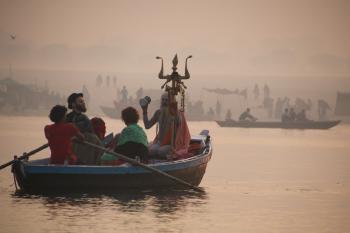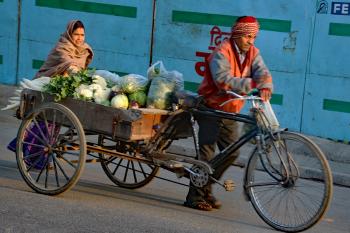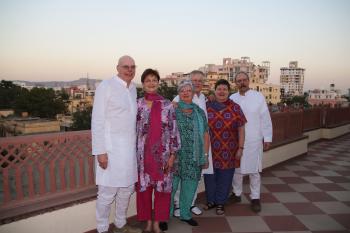Impressions of India
This article appears on page 20 of the January 2017 issue.
They walked, thousands of people, each with a look of hope and salvation. They carried small cloth bags over their shoulders, some, a small metal pot, and, every now and then, there was someone grasping a yellow flag. From my vantage point in our 10-passenger van, they seemed to walk in silence through the din of the surrounding city.
The crowd was headed to the Ganges to cleanse their souls, while the people on the other side of the street streamed out of the city with a look of going home.
Spirituality and superstitions
India is the most religious and most superstitious place my wife, Betty, and I have ever been.
One of our guides proudly showed us his rings. There were three on one hand. All held small, oval stones of light colors — off-white, green and dull ruby. The ruby one had special powers to improve just about any human condition needing improvement. All of them, we were assured, were scientifically proven.
When you grow up in a country where resources are short, labor is so plentiful it is dirt cheap, and social constraints have been welded into place by 4,000 years of religion, there is little hope of making a better life for yourself. When all realistic hope fades away in the daily grind of staying fed and clothed, superstition steps in to make it all more bearable.
The price of a fake ruby ring is small compared to the strength it delivers from your finger — hope where you can see and feel it.
India was a place our tour group saw at a distance, through the window of our van or as part of the crowds at the traditional tourist sites. I would have liked to stop in some of the little villages to walk down the alleys where they seemed to repair absolutely everything, since nothing is ever thrown out if it has any conceivable life left in it.
In the cities, pretty much everything else is thrown out. The refuse of daily life builds up in the streets, so, at times, it was hard to not view the discarded paper, plastic, food scraps and cow dung as a carpet of daily existence. The smell of burning refuse was a constant perfume in the larger cities.
The smaller towns were, in contrast, relatively clean. Sure, the streets were dirt or simply extensions of sidewalks that met in the center, between the buildings, but there were women out at all times sweeping the trash into little piles to be removed.
Spectacular sights
Centuries of cheap labor and a system that allows for the concentration of a country’s wealth in the hands of a very few have resulted in the creation of some spectacular buildings. Probably on the top of the list is the Taj Mahal.
This huge edifice, though absolutely stunning, was constructed for the totally unproductive purpose of being a tomb, a tomb for one person.
Made of brick, the Taj Mahal is covered with white translucent marble. It is adorned not with carvings, like the country’s Hindu temples, but with inlaid stones of blue, green, red and yellow that have been cut to meet the surrounding marble perfectly. A gnat wouldn’t notice as it crossed from one stone to the next.
As we traveled through the north of the country, the scene outside our moving window was the same and different at the same time. The shops, squeezed one against the other, all sold the same merchandise, the sellers of pots and pans, bedding, used tires and hardware all clustered together like birds of a feather. There was no advertising because everybody knew that if you wanted a new water pot, you headed to XYZ street, where there were rows of shops all selling water pots.
Mechanical-repair shops were characterized by the oil-soaked dirt, and those selling bedding had the brightly colored bed covers stacked up in great piles out front.
As we drove by, it seemed that all the products of India were on display right outside our windows.
Every night, all six of us on the tour held what we euphemistically called a “recap.” It was, in fact, simply a chance to be with people who enjoyed each other’s company and to test (again) our collective belief that Old Monk was the best rum we had ever tasted!
Operated by Journeys International, our tour was officially titled “Taj Mahal, Temples & Tigers” ($4,900 to $5,250 per person, depending on group size, for 16 days, land only). However, our group formed what we thought was a more appropriate name (thanks go to Walter): “Bengals, Bangles & Beer.”
Kingfisher beer comes in 650ml bottles, the equivalent of two US beers, so we had two bottles, each, to end the evening. That, a nip of the Old Monk, a few chips and some unidentifiable crumbly things from a stand in the street and you had a meal!
Certainly, we have made some very good friends on our trips, but never before has the entire group preferred to be together at the end of a long day rather than go back to their rooms to rest.
An exciting day
Now for the tiger part of our “Bengals, Bangles & Beer” tour.
Bengal tigers had almost been erased from the face of the world, but just in the nick of time, India created several huge preserves to protect its few surviving tigers.
We did not expect to see a single one, but we saw three (as well as a rarely spotted leopard, resting at the bottom of a ravine).
Our first (and best) sighting of a tiger was more up to luck than anything. We were in an open jeep that seated six people on two bench seats behind the driver and guide. I was in the back.
We soon found ourselves driving toward a large group of vehicles stopped in the road — a sure indication of something interesting. Sandwiched between us and the crowd of vehicles was a tiger.
As the tiger started to walk up the road, our vehicle turned around, giving those of us in the back row a “front-row” view. It followed us up the road for a good 20 minutes, stopping to mark every prominent tree and rock along the way and refilling its tank at a small stream that crossed the road.
When it spied some deer on a hill, the tiger crossed the small ravine, still watching the deer, but as soon as they saw the tiger, the deer gave their characteristic grunts of warning, and the tiger realized the hunt was over.
It then sat next to a large cactus, yawned and looked at us, and everyone in our group agreed: if we never saw another tiger, we would have had our wildest dreams fulfilled.
We saw two more.
Also part of this tour were visits to two private homes. They each had a bare bulb for light, openings in the walls for windows and mosquitoes for company, but they were clean enough to eat off the floor. The owners obviously had pride in their homes, and each home had a significant room devoted to worshiping their god. Hinduism has many gods, and worshipers are free to choose the ones that fit best into their lives.
Summing up
In the end, we got into our van and headed to the airport. We had seen about as much of India as one can see in 15 days. We had seen the tourist sites, and we had seen (mostly from our tour van) the small towns. We had seen the burning of bodies in Varanasi and the total devotion of pilgrims hoping for salvation and a better afterlife.
As I think about this trip, I have to tip my hat to Gail Scherer of Journeys International (Ann Arbor, MI; 800/255-8735, www.journeys international.com). Gail fixed all the little things that always seem to go wrong on any trip. She should be given a lot of credit for how good this trip was for the rest of us.
If I know Gail, she will deny her assistance, but it was there in a thousand little ways, from fixing a room to convincing me I should not try to drive the guide’s jeep (as much fun as that might have been for me and terrifying for everybody else).
Then there was Walter, her husband, who had the sharpest wit of anybody I know.
If you travel with Journeys, see if Gail and Walter will go. You won’t regret a minute of it.




